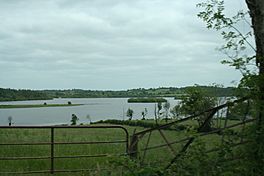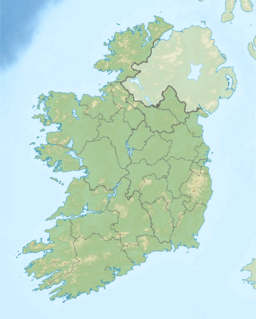Lough Gowna facts for kids
Quick facts for kids Lough Gowna |
|
|---|---|
 |
|
| Location | County Cavan |
| Coordinates | 53°51′N 7°33′W / 53.850°N 7.550°W |
| Type | Moraine dammed lake |
| Native name | Loch Gamhna Error {{native name checker}}: parameter value is malformed (help) |
| Primary inflows | River Erne |
| Primary outflows | River Erne |
| Basin countries | Ireland |
| Islands | Inchmore |
| Settlements | Loch Gowna, Colmcille, Mullinalaghta, Dromard, Mullahoran |
Lough Gowna (which means calf lake in Irish) is a beautiful freshwater lake. It is the very first lake on the River Erne. You can find it right on the border between County Longford and County Cavan in Ireland. Most of the lake is actually in County Longford.
Contents
How Lough Gowna Was Formed
Lough Gowna is a special type of lake called a moraine-dammed lake. This means it was created at the end of the last Ice Age. Huge glaciers left behind piles of rock and dirt called moraines. These moraines blocked the water, forming the lake.
The lake has a very wiggly shape. This is because of the hills underneath it, called drumlins. These drumlins were also formed by glaciers. The lake's shape gives it many small bays and inlets. These are often connected by narrow water paths.
The River Erne flows into the eastern part of the lake. It then flows out northward through County Cavan. Other small rivers also feed into the lake. The border between the counties runs through the lake. The western and southern parts are in Longford. The north-eastern parts are in Cavan.
The Lake's Surroundings
The north-western and south-western parts of the lake are linked. They connect through a narrow channel at a place called Dernaferst. This area is known for its natural beauty.
The northern and eastern shores of the lake have lots of peat bog. Peat bog is a type of wetland with spongy ground. Along the southern shores, you can find planted woodlands. These woods are in areas that used to be large estates.
Lough Gowna is a very important place for birds. Many wildfowl spend the winter here. It's a great spot for birdwatching.
Inchmore Island and Its History
The lake has one large island called Inchmore. Its Irish name, Inis Mór, means "Big island." This island is in the south-western part of the lake.
Inchmore was once home to a monastery. It was started in the 500s by Saint Colmcille. This monastery had a long history.
- In 804, Vikings attacked the monastery. They burned and looted it.
- In the 1100s, the abbey became part of the Augustinian order.
- It stayed an abbey until 1543. This was when Henry VIII closed many monasteries.
You can still see the remains of the abbey on the island today. Local people used the site as a graveyard until the early 1900s. A special bell from the 1400s was found in the 1800s. People believe it came from the monastery. This bell now hangs in the Roman Catholic church in Aughnacliffe.
Fun and Tourism at Lough Gowna
Lough Gowna is a popular spot for coarse fishing. This type of fishing targets non-salmon fish. The lake's shape, with its many bays and wooded areas, makes it very attractive for visitors.
There are nice picnic spots around the lake. You can find them at Dernaferst and at Dring. Dring is located at the very southern tip of the lake. These spots are perfect for a family day out.
The Legend Behind the Name
The name Lough Gowna comes from an old Irish legend. The story says a magical calf escaped from a well. This well was in a townland called Rathcor, south of the lake.
As the calf ran north, water from the well followed it. This stream of water flooded the area. That flood created the lake we see today. So, the lake is named after this legendary calf.
The Village of Loch Gowna
The lake gives its name to the village of Loch Gowna. This village is on the north-eastern shore of the lake. It is located in County Cavan.
The village used to be called Scrabby. Its Irish name was Screabach. In 1950, the villagers voted to change the name. They wanted it to be officially called Loch Gowna.
Today, the village is a hub for tourism. It has hotels and many holiday homes. It provides services for people visiting the lake.
Nearby Areas
Several other areas are next to Lough Gowna.
- Colmcille is on the western and southern shores.
- Mullinalaghta is on the eastern shore.
- Dromard is in the far north-west.
- All these are in County Longford.
- Mullahoran is in the far east of the lake. This is where the River Erne enters. It is in County Cavan.
Gallery
See also
 In Spanish: Lough Gowna para niños
In Spanish: Lough Gowna para niños




